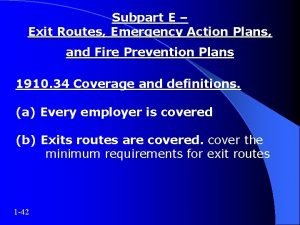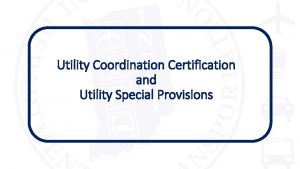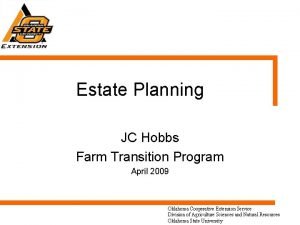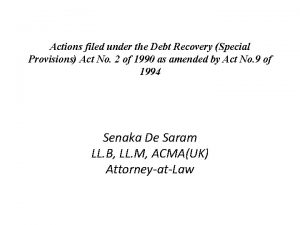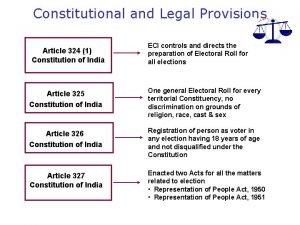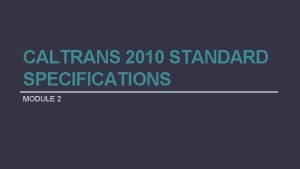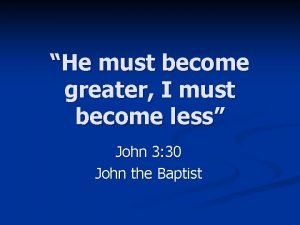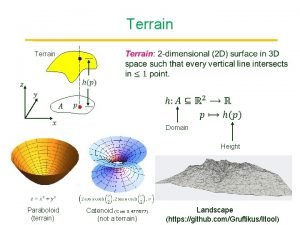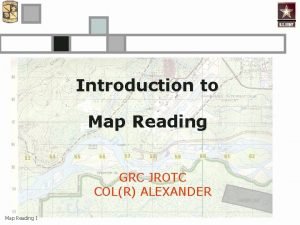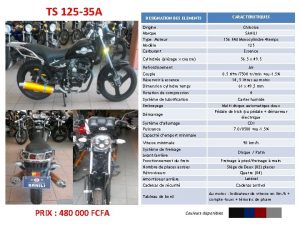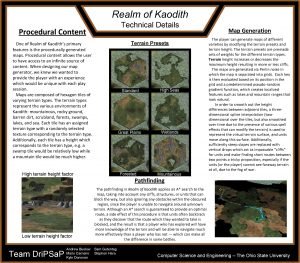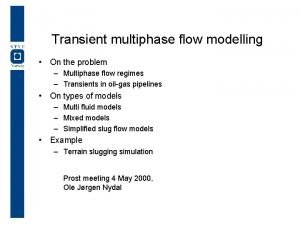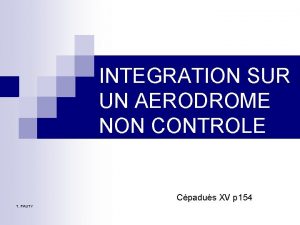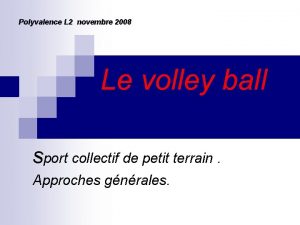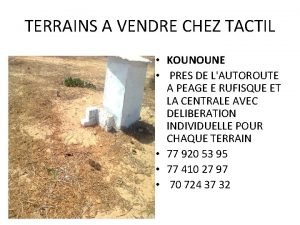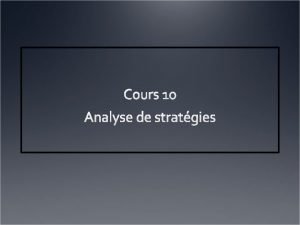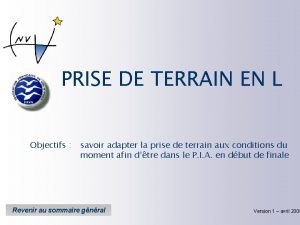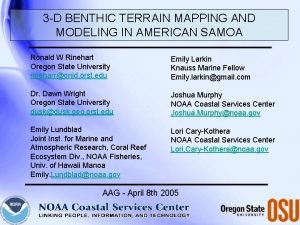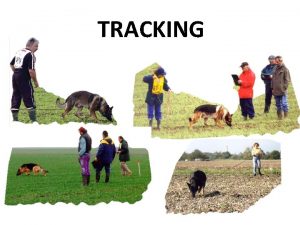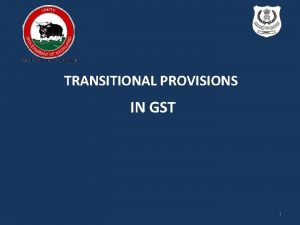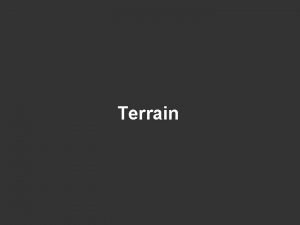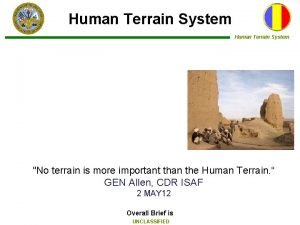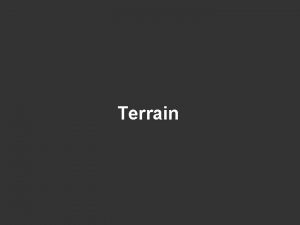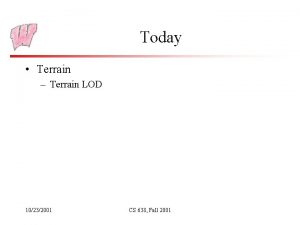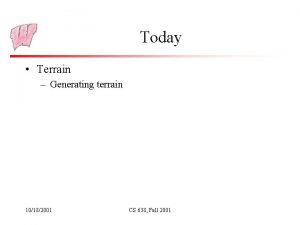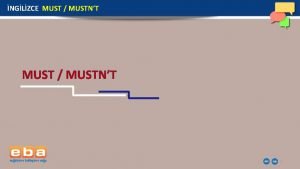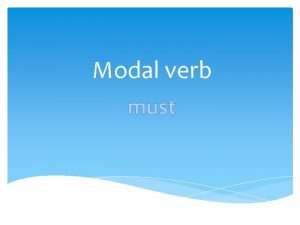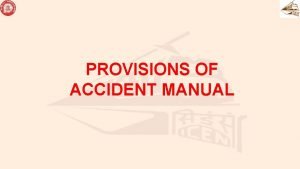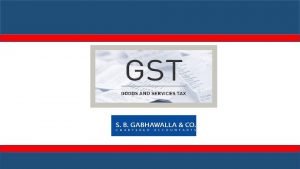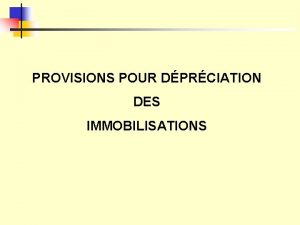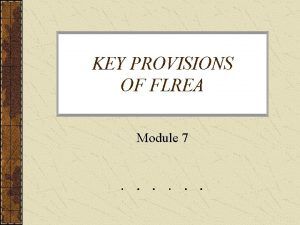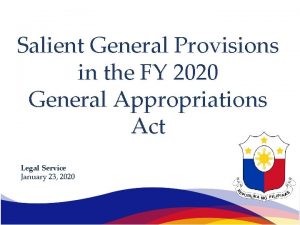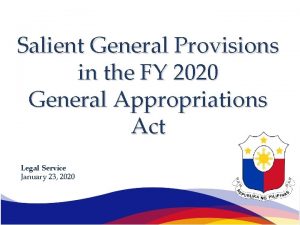TRACKING General Provisions The tracking terrain must meet











































































- Slides: 75

TRACKING

“General Provisions" • The tracking terrain must meet the conditions given in the FCI IGP trial rules. All natural soils may be used. • The judge or tracking coordinator determines the layout of the tracks. • The layout should be adapted to the terrain. • The different tracks must have different layouts.

“General Provisions" Regarding motivational objects: No motivation objects can be in the handler's possession at any time on the tracking field.

“General Provisions" • The scent pad is to be marked by a “start flag”. • The “start flag” is to be put immediately to the left of the scent pad, next to the tracklayer. • The order in which the participants track is to be determined by drawing lots. The judge must see to this

IGP 1 - 3 Phase "A" "Laying the tracks" • Prior to laying the tracks the tracklayer/dog handler must show the articles to the judge or the tracking coordinator. • The tracklayer must linger briefly at the start of the track. • The track is to be laid in normal paces in the specified direction. • The corners are also to be laid in normal paces.

IGP 1 - 3 Phase "A" "Laying the tracks" • The corners has to be “closed corners”. (in the regulations) •

"Laying the tracks" • While the IGP 1 – tracks are being laid, the dog must be out of sight. • While the IGP 2 + 3 – tracks are being laid, the dog handler and dog must be out of sight. • Articles are not to be laid within 20 paces before or 20 paces after a corner.

REPORT IN • Must be done in the basic position. • The dog is allowed to be reported in on a short leash. • The dog must be ready to track. • Report the way of indicating or retrieving. • Report out must be done in the basic position.

Requirements IGP 1 Handler-laid, minimum 300 paces, 3 legs, with 2 corners (about 90°), 3 articles, aged at least 20 minutes. On judge instruction: 1 st article on the first leg, 2 nd article on the 2 nd leg, 3 th article at the end of the track. Tracking must be completed in 15 minutes. Possible layouts of tracks Distribution of points: Following the track 79 Points Articles (3 x 7) 21 Points Total 100 Points Each may be to the left or to the right

Requirements IGP 2 Laid by a tracklayer, minimum 400 paces, 3 legs, with 2 corners (about 90°), 3 articles, aged at least 30 minutes. 1 st article after min. 100 paces, 2 nd article on the 2 nd leg and 3 th article at the end of the track. Track must be completed in 15 minutes. Possible layouts of tracks Distribution of points: Following the track 79 Points Articles (3 x 7 ) 21 Points Total 100 Points Each may be to the left or to the right

Requirements IGP 3 Laid by a tracklayer, minimum 600 paces, 5 legs, with 4 corners (about 90°), 3 articles, aged at least 60 minutes. 1 st article after min. 100 paces, 2 nd article on the 2 nd OR 3 TH leg and 3 th article at the end of the track. Track must be completed in 20 minutes. Possible layouts of tracks Each may be to the left or to the right Distribution of points: Following the track 79 Points Articles (73 x 7) 21 Points Total 100 Points

IPO 1 - 3 Phase "A" Handler help through unnatural motion –in the entire area of the track, in particular, near corners, –near change of terrain, –before placing the articles (IGP 1) Will lead to deduction of the score

“Starting the track" It is not faulty at the start of the track for the dog to be slightly ahead of the handler as they approach the track as long as the dog is calm. Evaluation of tracking, begins at the start of the track! This is at the starting flag!!

Tracking • If, with the permission of the judge, the dog is downed by the handler during the track for wild game or to untangle line around the legs: • The restart is done with the handler at the END of the line. • If downed for game, the handler stays at the end of the line. • If downed to untangle, the handler goes to the dog, untangles the line then returns to the end of the line to restart from there.

Tracking • In certain situations the dog will track with an open muzzle. • This is not faulty, because in some situations the dog will use also the special place in the palate of the dogs mouth. • This special place is connected to the so called “Jacobson organ” and helps the dog in difficult situations to identify the scent.

The Dogs mouth

IGP 1 - 3 Phase "A" “Starting the track" • The start of the track: Inspection by the dog of the scent path does not depend on duration. It is not a criteria for a negative evaluation.

IGP 1 - 3 Phase "A" “Starting the track" • Desirable is. . . – A calm and confident start – Picking up scent intensively and follows it convincingly. • Faults are. . . – Taking insufficient scent – Hectic and panicky start – Being under pressure at the start – Under force at the start – Avoidance at the start and when beginning to track

HOW TO JUDGE The start runs into the evaluation of the 1 st leg. IGP 1 and 2 = 1 x 27 (first leg) 2 x 26 points (second and thirth leg) IGP 3 = 4 X 16 points (first four legs) 1 X 15 points (last leg) After judgement of the work in qualification, the convertion in points has to follow

IFH-V Handler laid track: Min. 600 paces. 5 legs and 4 corners. 1 of the 4 cornes is a sharp corner ( between 30 -60 degrees) Distance between corners at least 50 paces. 3 own articles: 1 th article after at least 100 on 1 th or 2 nd leg. 2 nd article on 2 nd or 3 th leg. 3 th article at the end of the track. Points 3 x 5 + 1 x 6. Ageing time of track=90 minutes. Working time max. 20 minutes. Pre-requisite: BH/VT

IFH-1 Strange track, at least 1200 paces. Legs: 7 Corners: 6 about 90 degrees. Distance between corners at least 50 paces. Stranger’s articles: 4 strangs: 3 x 5 points + 1 x 6 points 1 st article after a minimum of 100 paces from the start, 2 nd and 3 rd according to the track Layer sketch, 4 th at the end. Ageing Time: 180 minutes. Working Time: Maximum 45 minutes Prerequisite: BH/VT

IFH-2 Strange track, at least 1800 paces Legs: 8, of which 1 is a semicircle with 30 mtr Radius. Corners: 7 of which at least 2 acute/ sharp corners (30 -60 degrees). Distance between corners at least 50 paces. Stranger’s articles 7: 7 x 3 points 1 st article after a minimum of 100 paces from the start, 2 nd – 6 th according to the Track layer sketch (2 articles on one leg is permissible), 7 th at the end.

IFH-2 Ageing Time: 180 minutes. Working Time Maximum: 45 minutes. Cross track timing: 30 minutes before the start. Prerequisite: BH/VT or IFH -1

IGP-FH 2 X IFH-2, on 2 different days in one trial. 2 x 1800 Paces, 2 different places, 2 different track layers, (2 different Judges. )? ? ?

Cross tracks • Cross tracks shall not be laid within 40 paces before or 40 paces after a corner. • Cross tracks may not be laid in the first or in the last leg. • Cross track may not cross a leg 2 times. • Cross tracks shall not be laid in an angel under 60 degrees.

IGP-V • • • Handler laid track. At least 200 paces Legs: 2. Corners: 1 about 90 degrees. Articles: 2 own articles. Articles are to be placed on the track on Judge’s instruction. Ageing time: no Working time maximum: 10 minutes Working the track: 79 Points Articles: 21 Points Prerequisite: BH/VT

IGP-ZTP • • • Handler laid track. At least 300 paces. Legs: 3 Corners 2 about 90 degrees. Articles: 3 own articles Articles are to be placed on the track on Judges instruction. Ageing time: 20 minutes Working Time Maximum. 20 minutes Working the track: 79 points Articles: 3 x 7= 21 points Prerequisite BH/VT

“The legs“ The legs are to be worked out with positive tracking behavior, intensive, with concentration and convincingly, with a deep nose and a uniform tracking tempo. It is not faulty if. . . –The dog checks without leaving the track. HR 09/02

“The legs“ • Faults include. . . – Partially high to high nose in parts or during the entire track – Circling – Insufficient intensity – Lack of concentration due to environmental influences – Under pressure and/or listless tracking – panicky and hectic tracking – Uncertainty und panicky behavior when solving problems

Behaviour on the legs The determining factor for a positive, high evaluation in the overall behaviour on the legs is: intensive, active yet calm tracking. You should “feel” the dog’s “desire to track”. Hunting dog judges speak of socalled: “ will to find “.

“The corners" • What is the corner? • The corner is the point were two legs, in different directions, are connected. • How to judge the corner?

“The corners" • The corners are to be worked out confidentially and with a “deep nose”. • It is not faulty if. . . – The dog checks to the left or right, without circling or leaving the track, when the direction changes, i. e. near an corner. – Over-running an corner by one pace

“The corners" • Faults include. . . – Large or small circles – Over-running corners by more than a pace – Faulty intensity at and after an corner – Lack of concentration due to environmental influences – Uncertainty and panicky behaviour when solving problems – Uncertainty in committing to the next leg

CORNERS • For all trial levels: The evaluation of the corner runs into the next leg IGP 1 und 2: 1. Start and 1 th leg = 26 Points 1 th Corner and 2 nd leg = 26 Points. 2 nd Corner and 3 rd leg = 27 Points. 79 Points IGP 3: Firts leg (including the start) = 15 Points Each corner and the following leg= 16 Points. (4 x) 79 Points

Corners

“The articles" • Articles may not differ significantly in color from the terrain. • Articles must shown to the judge before laying the track. • In case of championships/ FH examinations the articles must be numbered according to the track number.

“The articles" • Indicating the articles The indication of the articles must be convincing. The speed with which a dog indicates is not necessarily a criterion for evaluation, it must be consistent with the tracking tempo. • The desirable indication is if the dog. . . – indicates the article convincingly. – indicates the article in a straight line to the track. Indicating a little crooked is not faulty. – The article is indicated without hesitation. – Remains calmly at the article until being restarted. – - Restart must be done on the side where the article was picked up.

“The articles" • The indication is faulty if the dog. . . – Doesn’t indicate the article convincingly. – Indicates the article too early. – Indicates to the side of the article. – Lies on top of the article. – Is restless at the article. – Picks up the article, (some dogs do so because of stress) when otherwise reported to the judge. – Receives verbal “help” or “help” with the leash. – Anticipates the restart.

“The articles" • Retrieve / Picking up the articles: Picking up the article must be done immediately. • Desirable “picking up” is, if the dog: – Picks up the article immediately. – Holds the article calmly and firmly in its mouth. – Brings the article directly to the handler. (retrieve) – remains calm until the restart. – Restart must be done at the place where the article is taken.

“The articles" • “Picking up” is faulty if the dog. . . – – – – Picks up the article reluctantly and uncertainly. Doesn’t hold the article calmly in its mouth. Drops the article. Downs with the article. (permitted is; stay, sit or retrieve) Goes forward with the article. Doesn’t want to give up the article. ( 3 comm allowed) Receiving help, verbal or with the leash. Anticipates the restart.

“The articles" • The handler may approach the dog from either side to pick up the article, BUT they must then restart the dog from the SAME side they showed the article. • Praise is only allowed before or after picking up the article, not both. • The dog must release / give the article with 3 or fewer commands or it will be DQ.

The Articles • If an article that is not found by the dog and the Tracklayer can not find it, there will be no deduction. • If several articles are not found, there will be a re-track. • If a re-track is not accepted, the not found articles will be deducted. • This is not the case in the tracks where the dog handler laid the tracks.

ARTICLES • For all examination levels: If the dog stops tracking by falsely indicating an article and the dog handler (HF) does not go to the dog but gives an extra command at the end of the tracking line “SEARCH“: Deduction is -2 points. In IFH-2 / IGP-FH - 1 point

Articles • If the dog stops tracking by falsely indicating an article and the dog handler (HF) does go to the dog, and gives the tracking command at the side of the dog "Search" : Deduction is -4 points. In IFH-2 / IGP-FH - 2 points


“Tracking speed" The tracking tempo is not a criterion for evaluation if the dog. . . – Works out the entire track with the same tempo. • It is faulty if. . . – The tracking tempo changes during portions*) of the track • In particular if. . . – The tracking speed changes after a corner – The tracking speed changes after the start/restarts – The dog gallops *) Comment: Doesn’t apply if the difficulty of the terrain changes during the course of the track.

Additional criteria for evaluation Differences in tracking grounds Nature of the soil Disruption of the soil Height of vegetation Change of terrain Cross-tracks (due to people or animals) Influence of the weather (Rain, Snow) Air pressure, humidity High temperature Heavy wind Dampness of the ground

Tracking In Phase A a dog must have learned during training, that in the ideal case it must be responsible for 100% of the decisions. The dog must lead. The level of training can be seen in particular in the behavior at the start, at the corners, in committing to the legs following corners, and at the restarts after the indication of the articles. Superficial behavior, long periods of inactivity as well as help of diverse forms must result in appropriate deductions. The overall impression must be the deciding factor.

Judging Articles

Track Article

Track Article

Track Article

Track Article

90° indicate Track Article

Track Article

Track Article

Track Article

Track Article

Track Article

Track Article

Track Article

Judging How to judge tracking according to the FCI IGP Regulations

JUDGING The FCI IGP Regulations must be leading in the judgement of the judge

Judging Tracking A Judge must know all the FCI IGP Tracking Regulations

Judging tracking A judge must not judge according to his personal interpretation of the FCI IGP Regulations.

JUDGING TRACKING To judge correctly, a Judge must know: - what is a track. - how to lay a track - what can/will influence the track. - the ideal picture of indicating. - difficulties of different soils. - How to lay / work out an FH track.

JUDGING TRACKING - What is the moment of indicating an article? - What is, according to the IGP regulations, a correct indication?

JUDGING Tracking A Judge must be able to different between a local club trial and a Championship.

Judging Tracking A Judge should not “Kill” the dog sport by his judgement. He/ she must also be a “Teacher” for the dog sporter

Judging Tracking A Judge must be able to “Read” the “body language” of the dog.

Body language? ?

Judging Tracking A Judge must evaluate what he/she is seeing and not what he/she suspects.

Judging Tracking Before each exam /trial every judge should read once again the regulations.

JUDGING During the IGP Judge education seminars of the FCI, the way to judge, in an more equal way, by all judges, is discussed and agreements how to evaluate excersices are made. This must be spread to colleagues in the home countries.

THE END THANK YOU FOR YOUR ATTENTION
 Peace be with you till we meet again
Peace be with you till we meet again 1910 subpart e
1910 subpart e Fema provisions
Fema provisions Utility coordination
Utility coordination Life insurance contractual provisions
Life insurance contractual provisions Life insurance contractual provisions
Life insurance contractual provisions New hobbs farm and provisions
New hobbs farm and provisions What are three political problems postwar governments faced
What are three political problems postwar governments faced Life insurance contractual provisions
Life insurance contractual provisions Define decree nisi
Define decree nisi 2015 nehrp recommended seismic provisions
2015 nehrp recommended seismic provisions Article 325
Article 325 Trust reporting services
Trust reporting services Esf+ regulation
Esf+ regulation Caltrans revised standard plans
Caltrans revised standard plans I must become less
I must become less A general association of nations must be formed
A general association of nations must be formed Thế nào là sự mỏi cơ
Thế nào là sự mỏi cơ độ dài liên kết
độ dài liên kết Trời xanh đây là của chúng ta thể thơ
Trời xanh đây là của chúng ta thể thơ Chó sói
Chó sói Thiếu nhi thế giới liên hoan
Thiếu nhi thế giới liên hoan điện thế nghỉ
điện thế nghỉ Tia chieu sa te
Tia chieu sa te Một số thể thơ truyền thống
Một số thể thơ truyền thống Thế nào là hệ số cao nhất
Thế nào là hệ số cao nhất Frameset trong html5
Frameset trong html5 Sơ đồ cơ thể người
Sơ đồ cơ thể người Các số nguyên tố
Các số nguyên tố đặc điểm cơ thể của người tối cổ
đặc điểm cơ thể của người tối cổ Mật thư tọa độ 5x5
Mật thư tọa độ 5x5 Các châu lục và đại dương trên thế giới
Các châu lục và đại dương trên thế giới Tư thế worms-breton
Tư thế worms-breton ưu thế lai là gì
ưu thế lai là gì Tư thế ngồi viết
Tư thế ngồi viết Thẻ vin
Thẻ vin Bàn tay mà dây bẩn
Bàn tay mà dây bẩn Các châu lục và đại dương trên thế giới
Các châu lục và đại dương trên thế giới Bổ thể
Bổ thể Từ ngữ thể hiện lòng nhân hậu
Từ ngữ thể hiện lòng nhân hậu Tư thế ngồi viết
Tư thế ngồi viết Ví dụ giọng cùng tên
Ví dụ giọng cùng tên Thể thơ truyền thống
Thể thơ truyền thống Chúa yêu trần thế
Chúa yêu trần thế Sự nuôi và dạy con của hươu
Sự nuôi và dạy con của hươu đại từ thay thế
đại từ thay thế Diễn thế sinh thái là
Diễn thế sinh thái là Vẽ hình chiếu vuông góc của vật thể sau
Vẽ hình chiếu vuông góc của vật thể sau Phép trừ bù
Phép trừ bù Cong thức tính động năng
Cong thức tính động năng Thế nào là mạng điện lắp đặt kiểu nổi
Thế nào là mạng điện lắp đặt kiểu nổi Tỉ lệ cơ thể trẻ em
Tỉ lệ cơ thể trẻ em Lời thề hippocrates
Lời thề hippocrates Vẽ hình chiếu đứng bằng cạnh của vật thể
Vẽ hình chiếu đứng bằng cạnh của vật thể Quá trình desamine hóa có thể tạo ra
Quá trình desamine hóa có thể tạo ra Môn thể thao bắt đầu bằng từ chạy
Môn thể thao bắt đầu bằng từ chạy Hát kết hợp bộ gõ cơ thể
Hát kết hợp bộ gõ cơ thể Khi nào hổ mẹ dạy hổ con săn mồi
Khi nào hổ mẹ dạy hổ con săn mồi Các loại đột biến cấu trúc nhiễm sắc thể
Các loại đột biến cấu trúc nhiễm sắc thể Planos en cinematografia
Planos en cinematografia Where did general lee surrender to general grant?
Where did general lee surrender to general grant? The terrain domain
The terrain domain 5 major terrain features
5 major terrain features Moto sanili ts 125-6
Moto sanili ts 125-6 Terrain presets
Terrain presets Terrain slugging
Terrain slugging Integration aerodrome non controle
Integration aerodrome non controle Terrain in france
Terrain in france Benthic terrain modeler
Benthic terrain modeler Terrain volleyball dimension
Terrain volleyball dimension Terrain à vendre kounoune
Terrain à vendre kounoune New england colonies terrain
New england colonies terrain Marketing terrain
Marketing terrain Prise de terrain en u
Prise de terrain en u Depression terrain feature
Depression terrain feature Benthic terrain modeler
Benthic terrain modeler

